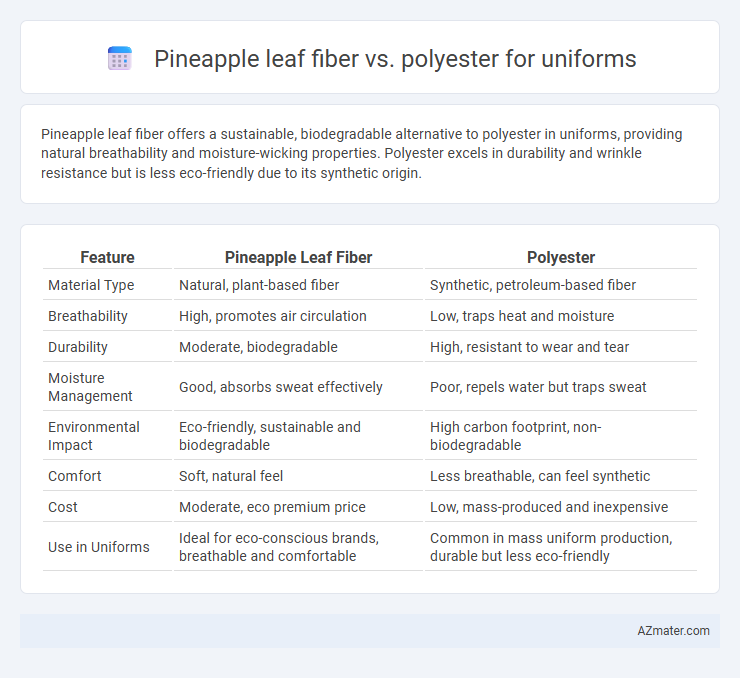Pineapple leaf fiber offers a sustainable, biodegradable alternative to polyester in uniforms, providing natural breathability and moisture-wicking properties. Polyester excels in durability and wrinkle resistance but is less eco-friendly due to its synthetic origin.
Table of Comparison
| Feature | Pineapple Leaf Fiber | Polyester |
|---|---|---|
| Material Type | Natural, plant-based fiber | Synthetic, petroleum-based fiber |
| Breathability | High, promotes air circulation | Low, traps heat and moisture |
| Durability | Moderate, biodegradable | High, resistant to wear and tear |
| Moisture Management | Good, absorbs sweat effectively | Poor, repels water but traps sweat |
| Environmental Impact | Eco-friendly, sustainable and biodegradable | High carbon footprint, non-biodegradable |
| Comfort | Soft, natural feel | Less breathable, can feel synthetic |
| Cost | Moderate, eco premium price | Low, mass-produced and inexpensive |
| Use in Uniforms | Ideal for eco-conscious brands, breathable and comfortable | Common in mass uniform production, durable but less eco-friendly |
Introduction: The Need for Sustainable Uniform Fabrics
Pineapple leaf fiber offers a renewable, biodegradable alternative to traditional polyester used in uniforms, addressing environmental concerns of synthetic fabric pollution. Derived from pineapple plant leaves, this natural fiber reduces reliance on oil-based materials and supports sustainable agriculture. Incorporating pineapple leaf fiber in uniforms promotes eco-friendly practices without compromising durability and comfort.
Overview of Pineapple Leaf Fiber
Pineapple leaf fiber is a natural, sustainable textile derived from the leaves of the pineapple plant, known for its high tensile strength and biodegradability. It offers excellent moisture-wicking and breathability properties, making it suitable for uniform fabrics requiring comfort and durability. Compared to polyester, pineapple leaf fiber is eco-friendly, reducing reliance on synthetic materials and lowering environmental impact in uniform production.
Key Characteristics of Polyester
Polyester, a synthetic fiber derived from petrochemicals, offers exceptional durability, wrinkle resistance, and moisture-wicking properties, making it ideal for uniforms that require frequent washing and long-lasting wear. Its hydrophobic nature allows quick drying, enhancing wearer comfort in various climates, while its innate resistance to shrinking and stretching maintains uniform shape and fit over time. Compared to natural fibers like pineapple leaf fiber, polyester provides superior strength, color retention, and ease of maintenance, supporting practical and economic advantages in uniform production.
Environmental Impact: Pineapple Leaf Fiber vs. Polyester
Pineapple leaf fiber, a biodegradable and renewable resource derived from agricultural waste, significantly reduces environmental impact compared to polyester, which is a synthetic fiber made from petroleum and contributes to pollution and microplastic contamination. The production of pineapple leaf fiber requires less water and energy, avoiding greenhouse gas emissions linked to polyester manufacturing. Choosing pineapple leaf fiber for uniforms supports sustainable fashion by minimizing waste and promoting a circular economy.
Durability and Performance in Uniforms
Pineapple leaf fiber offers superior breathability and biodegradability compared to polyester, making it ideal for eco-friendly uniforms that require moisture absorption and comfort. Polyester excels in durability with high tensile strength and resistance to abrasion, ensuring long-lasting performance under heavy use. Combining pineapple leaf fiber's natural ventilation with polyester's resilience can create uniforms that balance comfort and durability effectively.
Comfort and Breathability Comparison
Pineapple leaf fiber offers superior breathability and moisture-wicking properties compared to polyester, making it ideal for uniforms in warm climates. The natural fibers allow better air circulation and reduce sweat retention, enhancing overall comfort during prolonged wear. Polyester, while durable and wrinkle-resistant, often traps heat and moisture, leading to less comfort in humid conditions.
Cost Analysis: Production and Maintenance
Pineapple leaf fiber uniforms generally have higher initial production costs due to labor-intensive extraction and limited industrial-scale processing compared to polyester, which benefits from mass production and economies of scale. Maintenance expenses for pineapple leaf fiber are lower over time because the fiber is biodegradable and requires less chemical treatment, whereas polyester uniforms often incur higher costs related to washing and potential synthetic fiber degradation. Overall, polyester offers cost-efficiency in production, but pineapple leaf fiber may reduce long-term maintenance expenses, making it a sustainable alternative with variable cost dynamics.
Design Flexibility and Aesthetics
Pineapple leaf fiber offers superior design flexibility and a natural, textured aesthetic that enhances uniform appeal with eco-friendly attributes. Polyester provides a wide range of colorfast options and smooth finishes, enabling vibrant designs and durability in uniforms. The choice depends on balancing sustainability and vibrant, long-lasting aesthetics suited to specific uniform requirements.
Adoption and Industry Trends
Pineapple leaf fiber (PALF) is gaining traction in the uniform industry due to its sustainability, biodegradability, and natural breathability, aligning with eco-friendly adoption trends among brands seeking green alternatives. Polyester remains dominant because of its durability, moisture-wicking properties, and cost-effectiveness, but increasing environmental concerns are pushing manufacturers to explore bio-based fibers like PALF. Industry reports show a rising shift toward blends of PALF and synthetic fibers to balance performance with eco-consciousness in corporate and educational uniforms.
Future Prospects: Choosing the Right Fabric for Uniforms
Pineapple leaf fiber, a sustainable and biodegradable natural textile derived from agricultural waste, offers significant environmental advantages over polyester, which is a petroleum-based synthetic fiber. Future prospects for uniforms suggest a growing preference for pineapple leaf fiber due to its eco-friendly properties, breathability, and durability, aligning with increasing corporate sustainability goals and consumer demand for greener products. Innovations in fiber processing and blending techniques are enhancing pineapple leaf fiber's performance, making it a viable and responsible choice for uniform manufacturers aiming to reduce carbon footprints and promote circular fashion.

Infographic: Pineapple leaf fiber vs Polyester for Uniform
 azmater.com
azmater.com